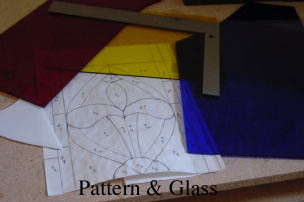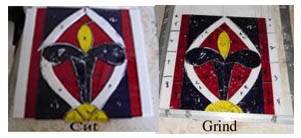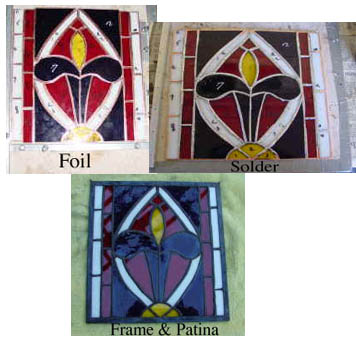
Centuries ago artisans found how to make glass and learned what they can do with it. Now-a-days glass is used for glamour, protection, warmth, storage or decoration. Glass pieces have been used in crafts, such as stained glass and mosaic art. The art of stained glass is colored glass pieces that had been dyed or painted and put together with strips of lead. This medium started mainly for use in northern Europe in church and cathedral windows. Stained glass was basically considered an architectural art.
In the medieval times, the same as today, a person who works with glass is called a glazier. Techniques of making a stained glass window can be described by this quote, "If you want to assemble simple windows, first mark out the dimensions of their length and breadth on a wooden board, then draw scroll work or anything else that pleases you, and select colors that are to be put in. Cut the glass and fit the pieces together with the grozing iron. Enclose them with lead cames..... and solder on both sides. Surround it with a wooden frame strengthened with nails and set it up in the place where you wish." (A History of Stained Glass)
Glass is made of silicon dioxide or silica that is turned into a supercooled liquid. Perfect glass is considered to have been heated to above 3000 degrees fahrenheit. The colors are made by fusing together various metallic oxides and salts to a molten ash and sand mixture. To produce diverse colors, the glassmakers would set the oven at different temperatures. Shades were limited to blue, red, purple, green, yellow, and white. Glass blowers would gather the molten glass at the end of a blowing tube. Then blew and twisted it into a cylindrical shape. Next, the glass-worker cut both ends, laid it on it’s axis until it cooled. To produce a flatten look, they would reheat in the kilm. The result was an uneven small sheet of glass that is now called medieval glass. A glass made today, similar in appearance, is called ‘antique glass.’ Larger sheets of glass were called ’pot metal.’
Stained glass became a popular medium to use in the design of cathedral windows. The difference in thickness and color with air bubbles or other flaws caused the glass to flex the sun’s rays. Throughout the day, this allowed the colored light to dance and sparkle around an interior space. In the cathedrals of Europe, frequent color schemes of the windows were cold colors in the walls facing North and West. The warm colors were in the eastern and southern walls.
Throughout the centuries, a glass border was common because it was decorative and functional. At times the artist would add a border to make the correct shape. The early perimeters were symmetrical and regular. Many times they were really wide and had an abstract style. Often the framing would repeat the stonework pattern. Other themes were of rosettes, foliage, crowns, animals, heraldic emblems, and figures. In the 12th and 13th centuries, beaded fillet was quite popular. There would be a thin strip of clear glass that had bead motifs painted on. The majority of the cathedral windows, during the 12th to the 16th century had some sort of decoration glass border.
During the 11th and 12th centuries, Romanesque or Norman cathedrals were based on Roman and Byzantine traditions. The windows were relatively small with tracery (stone work), which occasionally held clear glass. Wheel windows, which later on evolved into rose windows, were round and small openings. The design had thick stone spokes coming from the center. A popular window type was the medallion which held scenes from the Old and New Testaments or depictions of saints. Circular or square iron frames enclosed several sections of a scene. Another common type was the figure window. They showed a single figure in an awkward pose with heavy features and a stressed gesture. Usually the figures either sat or stood and looked straight ahead. Stylized organic ornament and decorative beading made a border around a scene and figure. Even with windows, the buildings interior remained very dark. Today, very few Romanesque windows remain. Many of the Romanesque cathedrals were burned down and rebuilt in the latest style, Gothic.
The rebuilding of St Denis, in about 1140 under the direction of Abbot Suger, is generally considered to be the beginning of the Gothic style. Suger has been considered ‘the father’ of Gothic architecture. One thing he wanted was illumination throughout the interior. The power of colored light through large stained glass windows set a mystical mood. Hugh of Saint-Victor once commented, "Stained glass windows are the Holy ScripturesÖand since their brilliance let’s the splendor of the True Light pass into the church, they enlighten those inside." (Kleiner, 500) The windows subject matters ranged from the simple figures to the extremely complex. The artisan’s themes were mainly of biblical stories or characters and people during the medieval time.
During the Gothic style, 12th and 13th centuries stained glass flourished. With more architectural support by barrel vaults and flying buttresses the cathedral walls could be thinner. By having elegant pointed arches, the structure could be increased in height. These structural changes resulted in allowing more and bigger windows. Within this style, the rose window developed. The circular flower-like windows had different types of tracery. Plate tracery consisted of a circle punched in the stonework. Later, bar tracery had slender bars forming geometric shapes. Know as flamboyant tracery, an s-shaped curve became popular in the 15th century.
During the 14th and 15th centuries, the Renaissance, Italian occhi or eye windows depicted scenes of the Virgin or Christ. They were not interrupted by tracery but were divided by horizontal and vertical bars. By this time, stained glass imagery became more naturalistic and realistic through the use of perspective. Not only could stained glass windows be seen in the cathedrals, but in homes as well.
During this time, the glass pieces became larger and images were to be painted on. The stained glass artist began to depict portraits and classical literature characters. Leads became thinner and decreased in its importance within the design. The art of stained glass began to decline because of the scarcity of colored glass. In the 16th century, very few were interested in the art of stained glass. Thus, this art became known as ‘the Lost Art" until it’s revival in the 19th century.
In about 1890, my grandfather’s grandfather was a sculptor and stained glass artist who restored windows in Europe. Recently I’ve become interested in stained glass. In September 2000, I took a class in the foil method. Originally, there was only the leaded glass method where came pieces held the glass together. Then intersecting joints were soldered. Louis Comfort Tiffany developed the foil technique because he wanted to add more detail in his lamps. The foil method involves wrapping the glass pieces with copper foil and soldering the front and back of the project to hold the glass together.
I decided I would like to create a Gothic look in a small stained glass panel. The foil method can still look very much like the ‘old world’ style. During the French Gothic, a common border theme was the fleur-de-lye. This project is an imitation of the border of a 13th century glass frame in Reims cathedral.

Doing this border project made me realize how beautiful and mystical the light through the vibrant colors would be. I can visualize the impact this would have in the larger cathedral stained glass windows. In the example I copied, I noticed the glass was irregular. I hand made the pattern and free handed the cutting to make the project look more authentic. Here are the steps to making the stained glass project. *Tools: safety glasses, glass cutter, breaking pliers, running pliers, glass grinder, black backed 7/32 copper foil, lead came, 60/40 solder, flux, 100W soldering iron, patina, carbon paper, card stock paper, sharpie pen, x-acto knife, scissors, pattern, glass, and a work surface
*First, the artist creates a cartoon and enlarges the pattern into the size he or she wants the project to be. Trace the pattern on card stock paper and cut each piece. Then comes the deciding of what color and texture should be used for every particular piece of glass. Glass used in this project are yellow cathedral, red antique, violet blue cathedral, and white.

*Next comes the cutting and grinding.

*Following those steps, rinse each piece in water, dry, and foil. Then place each piece in their proper place and keep them square. First, flux the inside corners and use 60/40 solder to hold pieces together. Tin the front and back. Then the artist beads the solder on the front. Cut a lead came border and solder joints together. After, clean panel and patina. Now it’s ready to hang.

Bibliography
Broke, Bob. Stained Glass. British Heritage. April/May 1997. Vol. 18: Issue 4. pg. 58, 3p, 3c.
History of Stained Glass. Online. April 22, 2001
Lee, Lawrence, Seddon, G., and Stephens, F. Stained Glass. New York: Crown Publishers Inc. 1976.
Kleiner, Fred S. and Christin J. Mamiya. Gardner’s Art Through the Ages. Volume I: Ch 18. New York: Harcourt College Publishers, 2001.
History of Stained Glass. Witraze. Online. May 28, 2001.
A History of Stained Glass. Online. May 28, 2001.